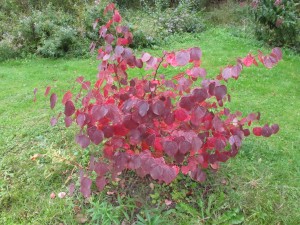Fall Color
Some years ago, in a moment of enlightenment, the New Hampshire legislature outlawed the propagation, transport and sale of three popular landscape plants: burning bush, barberry, and Norway maple. All three had been proven to be invasive, seeding into the woods and crowding out our native plants. Both Massachusetts and Connecticut have banned them, too, but so far Vermont, Maine and Rhode Island have not.
I agree with the ban. All three are thugs. Even where banned, the plant police will not come and take away your invasive plants, although I do recommend that you pull yours and replace them. I also understand why so many people love burning bush (Euonymus alatus), especially now when it displays brilliant red foliage. It will grow anywhere and stays a nice size.
There are good alternatives to burning bush that will provide good – even spectacular – fall color. The best I can recommend is fothergilla (Fothergilla spp.). This is a small to medium sized shrub with gorgeous white bottlebrush flowers in April and brilliant leaves starting now. It is slow growing, so it need not be pruned often, which I consider an advantage. The fall foliage can range from red and purple to yellow and orange – and I’ve had all 4 colors on one plant. A named variety, ‘Mt Airy’, is one of the best.
The common blueberry is another nice shrub that has red and yellow leaves in fall. The white blossoms in June are nice – and who knows, you might even beat the birds to a few berries. The trick to success with the berries is to get the soil very acidic by adding garden sulfur to the soil, or, right after flowering, add an acid fertilizer like Holly-Tone or Pro-Holly. But don’t add fertilizers now – you don’t want any soft new growth just before the winter.
Another great plant for fall color is redbud hazel (Disanthus cercidifolius). It is not commonly found in garden centers, but I predict it will be: the leaves turn a brilliant claret red to purple early in the autumn. I got one last year and it suffered from the cold winter with some branches dying back. It also was munched by deer. But it rebounded nicely this summer, and is putting on a great show. According to Professor Michael Dirr’s books, it might reach 6 to 10 feet tall, and does well in partial shade and moist, rich soil. Dirr says it is hardy to minus 20, and we saw temperatures colder than that last winter, so I should be glad mine survived.
Spirea is the common (and scientific) name for a group of shrubs commonly planted around post offices and municipal buildings. It is what I think of as an “urban survivor”. Like that banned burning bush, it requires little and will survive almost any conditions. There are some varieties that have excellent fall color. ‘Glow Flame’ and ‘Glow Girl’ are varieties with good red color that I have seen, though, not grown.
Some azaleas also develop good red colors. ‘Cornell Pink’ is a very early- blooming azalea that also has excellent red leaves right now – in some places, but not others. I saw two examples growing side-by-side. One had a nice burnt red color, the other had leaves that were still an ordinary green. Beats me why one should turn color, the other not.
Both the double file viburnum (Viburnum plicatum) and arrowwood viburnum (Viburnum dentatum) often have excellent red fall color. But like the azaleas mentioned above, there is limited consistency. If you want to get a specimen that shows good color, buy one with good color at the nursery and plant it now. Both produce nice white flowers in the spring and produce berries in late summer that are relished by birds. They are medium-sized shrubs that are pleasant additions to the landscape.
One word of warning: there is a viburnum leaf beetle, a foreign pest, that has recently appeared in the landscape and it can devour the leaves of viburnums and ruin their appearance – or even kill them. I’ve been told that this new pest came down from Montreal, so some northern gardens have been affected before those in southern locations.
One last suggestions to consider is the red chokeberry (Aronia arbutifolia. I bought one 10 years ago after reading about this species and seeing a specimen with brilliant foliage. What struck me was that the tops of the leaves in fall were red and the undersides were silver. But my specimen has not thrived, and I have moved it once on my property trying to find just the right place for it. It is generally said to be adaptable to soils and sun conditions, and the berries are so bitter that even the birds will not eat them. Still, it’s worth a look. My specimen has stayed about 6 feet tall.
As with anything we do in the garden, there are few guarantees when it comes to fall color. Burning bush? Yes. Red, year after year. And I’ve always been pleased with fothergilla. But even our favorite maples cannot be depended on to put on a spectacular show every year. So please don’t sue me if you pull out your burning bush and plant a spirea or a viburnum and it doesn’t perform as well! Each shrub we plant has its virtues.
Henry Homeyer is the author of 4 gardening books and is a UNH master Gardener. His web site is www.Gardening-Guy.com/.




